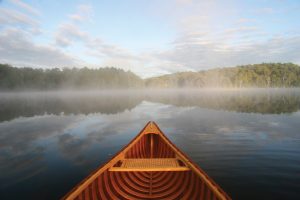As the weather warms for summer, nothing is more satisfying than paddling a placid stream or river. Relaxing in the sunshine and enjoying the serenity of nature and wildlife brings a feeling of relaxation, joy and peace.
There is an old saying, “Look before you leap.” It can also be applied to navigating a stream or river as, “Look before you launch.” High water stirs up sediment leaving water stained and muddy.
Small streams and rivers are wonderful paddling experiences during times of stable water levels, but strong spring storms can change their demeanor in a matter of hours. A recent downpour or heavy rainstorm upstream can change an easy-going waterway into a treacherous stretch of deadly rapids unnavigable by the most experienced paddler.
When waters are running high and fast, there are even more hidden dangers. One of the more common and deadly is strainers. Strainers are fallen trees with submerged branches. With high water rushing through the limbs, objects become pinned by the water pressure. A strainer can flip a canoe or kayak, and even a paddler wearing a proper life jacket or vest can be swept under and held in place by the force of the current.
Another dangerous situation facing paddlers is encountering a low head dam. These structures are generally concrete and have water flowing over them. Shooting over the dam in a kayak may be tempting, but the rolling hydraulic boil at the base can trap and drown even the most experienced paddler. Never attempt to paddle over a low head dam. Pull out and portage around it.
Paddlers new to the sport usually have questions. One of the top inquiries is if kayaks or canoes must be registered in Illinois. The answer is no. Non-motorized kayaks, canoes, paddle boards and other non-powered vessels do not need to be registered.
Water Usage Stamps for non-motorized water vessels were abolished in June 2018.
Illinois is explicit on requirements for U.S. Coast Guard-approved Personal Flotation Devices (PFD) for boaters. State law requires anyone under age 13 to always wear a life jacket while aboard any watercraft less than 26 feet in length while the boat is underway, unless below deck in an enclosed cabin or operating on private property. PFDs are required for persons of any age while operating a personal watercraft or jet ski.
Kayaking or canoeing at night can be a special experience but requires mandatory 360-degree white light visible for 2 miles.
Whenever you plan on kayaking or canoeing a river or stream, make sure you leave a copy of your float plan and approximate time of your return with a friend or family member.
Check water levels, stay sober, wear your PFD and take a spare paddle. There is one thing worse than being “up the creek without a paddle” and it is being “down the creek without a paddle.”










